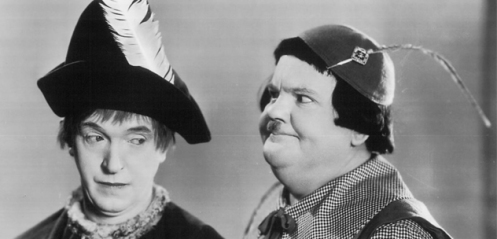It’s a White Christmas: Anti-Semitism and Racism in the Holiday Classic MARCH OF THE WOODEN SOLDIERS
30 December 2012
Stan Laurel and Oliver Hardy’s March of the Wooden Soldiers (1934), also titled Babes in Toyland, has gone down in American film history as a Christmas classic. True, the film is not holiday-themed—even if Santa Claus makes a cameo—,but its original December release in the mid-1930s coupled with the fact that television networks have aired the film during the holidays for over 40 years solidified March of the Wooden Soldiers’ place as a holiday classic. By now generations of people have adopted viewing this film as a Christmas tradition, and the film is widely regarded as a beloved gem from American cinema’s Golden Age.
Yet, contemporary audiences watching March of the Wooden Soldiers cannot help noticing some rather overt prejudice in the film, namely anti-Semitic statements made through the character of Silas Barnaby and racist views evident in the Bogey characters. Consciously, the film is not directly saying Jews are manipulative weasels and minorities should be held down and kept out of white society, but these sentiments are clearly expressed in the film and reflect a dangerous ideology more popular in yesteryear. Thus, in a 1930’s classic created to entertain the masses, what do contemporary audiences do with an accomplished film that unconsciously but explicitly offends modern principles?
Gus Meins and Charley Rogers’ March of the Wooden Soldiers takes place in Toyland, a place where children’s favorite fairytale characters live in harmony, literary because they are frequently singing or moving though the land to song. Stanley Dum (Stan Laurel) and Ollie Dee (Oliver Hardy) board with the Old Woman (Florence Roberts) who lives in a shoe; also living there is Little Bo Peep. Bo Peep is in love with Tom-Tom Piper (Felix Knight), but the old, sinister Silas Barnaby (Henry Brandon), the wealthiest resident of Toyland, has his eyes on Bo Peep. Barnaby holds the mortgage to the Old Woman’s shoe and tells her if Bo Peep marries Piper instead of him he will kick the Old Woman and her tenants out on the street. Stanley and Ollie try tirelessly to stop Barnaby from his blackmail, but Barnaby fires back every time. Eventually, Barnaby has Piper exiled to Bogeyland, an underground lair inhabited by Bogeys, violent and carnivorous creatures who eat people whole. When Piper escapes Barnaby unleashes the Bogeys on all of Toyland, and the people of this fairytale community must use their 6-foot toy soldiers, created by Ollie and Stanley, to fight the Bogeys if they want to save Toyland.
Sound like the fairytale of all fairytales? Well, maybe not. To begin, Silas Barnaby stereotypically represents a Jewish man. Physically he has classic Jewish features; he is also wealthy but tight with his money, corrupt, and manipulative. Characterized as a Jew, March of the Wooden Soldiers makes some rather anti-Semitic claims through Barnaby. One of these claims is Jews should be isolated and ignored; Barnaby is isolated in several ways: he lives alone and cannot get a wife without underhanded blackmail, he has no friends or kin, he wears all black clothes against the colorful people and places in Toyland, and he has a sinister, unmistakable musical score that accompanies his appearances in the film. Although a resident of Toyland, Barnaby is an outsider, but it is not only his wickedness that outs him but also the community’s repulsion of him that keeps Barnaby an outcast.
Moreover, Barnaby is the villain and villains are dangerous; the dangers related to Barnaby fuel anti-Semitic ideology unconsciously festering in the film. For example, Barnaby narrows in on Bo Peep, the beautiful, young, blonde-haired girl. Although she kindly tries to give Barnaby the cold shoulder, he poses a threat to her because he has financial power over her, which he uses to manipulate the situation and serve his own, selfish desires. Not far under the surface of the film is the suggestion Jews have money, hold on tightly to it, and this financial power can be used to devastate others. Another danger surrounding Barnaby that fuels anti-Semitic mentality is this depraved character is also well connected to other vile characters, and these connections can lead to an uprising and revolt that jeopardizes innocent people. The audience never learns how Barnaby gets so friendly with the Bogeys, but in the film’s dramatic climax Barnaby summons the Bogeys up from their underground home to attack the unsuspecting people of Toyland. Clearly, there is a strong suggestion that Jews are dangerous not only because they have money, but also because they are secretive, manipulative, and align with the underbelly if it serves their needs.
Anti-Semitism is not the only prejudice mentality in March of the Wooden Soldiers; the film also communicates racist beliefs through the Bogeys of Bogeyland. The Bogeys are brown creatures with black wiry hair who live underground; they hunt, terrorize, and devour people who cross their paths. When they rise up from Bogeyland and invade Toyland they are eventually met by the wooden soldiers, who, like every member of Toyland, happens to be white. The heroic soldiers are draped in traditional garb and sacrifice themselves for the good of the people, vanquishing those creatures who harm the white—or, perhaps, right—way of life. Conversely, the Bogeys run around wildly, climb all over the town like animals, destroy homes, and rip innocent children from their mothers’ arms, grunting because they are not able to speak. The clash between the Bogeys and the soldiers instantly signals racial conflict. If the soldiers and all residents of Toyland are white, then the Bogeys represent not only blacks but all minorities. The Bogeys are barbaric, illiterate, cave creatures, and—under antagonist Barnaby’s direction—they are the monsters of the film. March of the Wooden Soldiers communicates a hate-filled message against non-whites which suggests minorities, like the Bogeys, are dangerous; additionally, they should be kept out and forced down for the safety of whites and their way of life.
March of the Wooden Soldiers attempts to sell itself as “A delight for youngsters!” and “A treat for adults.” Yet, in looking at this film from a contemporary vantage point, it is difficult to find much delight or anything light at all; from this viewpoint this is a heavy-hitting film. And, it is almost certainly more a trick than treat.
With 21st century eyes it is not hard to find hatred, ignorance, and fear primarily regarding religion and race in March of the Wooden Soldiers. In fairness, the same can be said about most of March of the Wooden Soldiers cinematic contemporaries. Anyone remember when the Ku Klux Klan rescues Elsie and sets the ape-like black characters on fire in D.W. Griffith’s Birth of a Nation (1915)? (A film alternatively titled The Clansman.) Prejudice and hatred will all be there because film unconsciously reflects the common ideology of the people and place of its creation. But with time ideologies change, hence contemporary viewers quickly notice offensive comments, innuendos, and ideas in films of yesteryear based on their newer beliefs.
But, the big question is what do we do with what we notice? We cannot ignore it because then we cannot learn from it. We cannot condemn films like March of the Wooden Soldiers because they are artistic accomplishments for early cinema. Moreover, a film like March of the Wooden Soldier is historically significant as artifact, or evidence for a former way of thinking; the film is a resource for understanding the past.
So do we simply accept it and perpetuate its reputation as a beloved American holiday classic? Must be, since that is what we are doing. But, what about today’s children who watch this film? With developing cognitive skills, could young viewers still unconsciously ingest the harmful racial and anti-Semitic messages in the film? Does that matter? Or, more directly, does that matter enough?
What happens to films that have withstood the test of time, but, within that ever-evolving span of time, have ceased to entertain appropriately?
Rate this:
Related
~ by Kate Bellmore on 30/12/2012.
Posted in Holiday Classics
Tags: 1930s American film, Antisemitism, Barnaby, Bogey, holiday films, March of the Wooden Soldiers, Oliver Hardy, racism in cinema, Stan Laurel

















Another anti-Semitic addition to a movie: Why did Doctor Pretorious in BRIDE OF FRANKENSTEIN, put on a SKULL CAP when he was showing Henry Frankenstein the little people he created. Was that to, in case you did not notice it already, emphasize the idea that the evil doctor was JEWISH? See for yourself. lol
Paul Hutchins said this on 15/07/2014 at 3:05 PM |
Silas Barnaby looked more like Benjamin Disraeli, Queen Victoria’s favorite Prime Minister, England’s first and only Jewish Prime Minister. The toy maker looked like a clone of Samuel Gompers, the AFL founder…also Jewish. The Bogeymen obviiously were fictionalized Black People and the march on Toy Land was a “Race Riot” in fiction crushed by the lilly-Whjte Wooden Soldiers. I think a derogatory word for Black People in that era was “Boogies” or “Bogeys”. . It is obviouls to us in our more enlightened 21st Century these points. But we are so globalized and different (at that time Civil War Vets still were alive) culturally, the hidden message seems ridiculous by our standards. It would be interesting if this film was exported to Nazi Germany and what the movie mags and audiences over there thought of it. -if that data is available. THAT would be interesting.
Paul Hutchins said this on 15/07/2014 at 3:01 PM |
Silas Barnaby looked like Benjamin Disraeli, Victor
Anonymous said this on 15/07/2014 at 2:53 PM |
In New York, March of the Wooden Soldiers has been shown every Thanksgiving (not Christmas) since the 1960s. In fact, WPIX showed it just this past Thanksgiving 2013. As for you associating bogeymen with blacks or other minorities, that sounds more like the invention of your racially-charged mind than that of MGM Studios. And analogizing Silas Barnaby to a Jew is another stretch of your disturbed imagination. Barnaby is not ordinarily a Jewish surname, he wore a hat resembling the type of hat worn by Puritans, he did not have stereotypically Jewish facial features. Most important, MGM Studios, which produced the movie, was run exclusively by Jews in 1934. So much for your theory.
John said this on 10/01/2014 at 9:45 AM |
Wooden Soldiers runs on Christmas as well as Thanksgiving, but you are right that it is not exclusively shown for one holiday. I am sorry you seem offended by the post, yet I have to defend the post’s investigation of racism and anti-Semitism in the film. Retrospectively, the racial tension and anti-Semitic statements in March of the Wooden Soldiers are unmissable, but that is because the film was made during a time when racism and anti-Semitic sentiments were socially acceptable. I do not feel the film was made as a scathing attack on anyone, nor do I feel the film, upon its release, could have recognized any of the assertions I made about blacks or Jews. All I mean is that, when looked at through today’s 2013/2014 lens, contemporary viewers may find it difficult to enjoy the film because of its racist and anti-Semitic characterizations.
Kate Bellmore said this on 20/01/2014 at 8:57 AM |
If this is serious, the author needs to be institutionalized immediately and put antipsychotic drugs.
Ray said this on 05/01/2014 at 9:56 PM |
As the author, who is serious, I have noted your recommendation. Any chance you would be willing to elaborate before I check-in and drug up?
Kate Bellmore said this on 20/01/2014 at 9:01 AM |
Are you serious? LOL
Anonymous said this on 25/12/2013 at 1:25 PM |
Yes.
Kate Bellmore said this on 26/12/2013 at 9:49 AM |